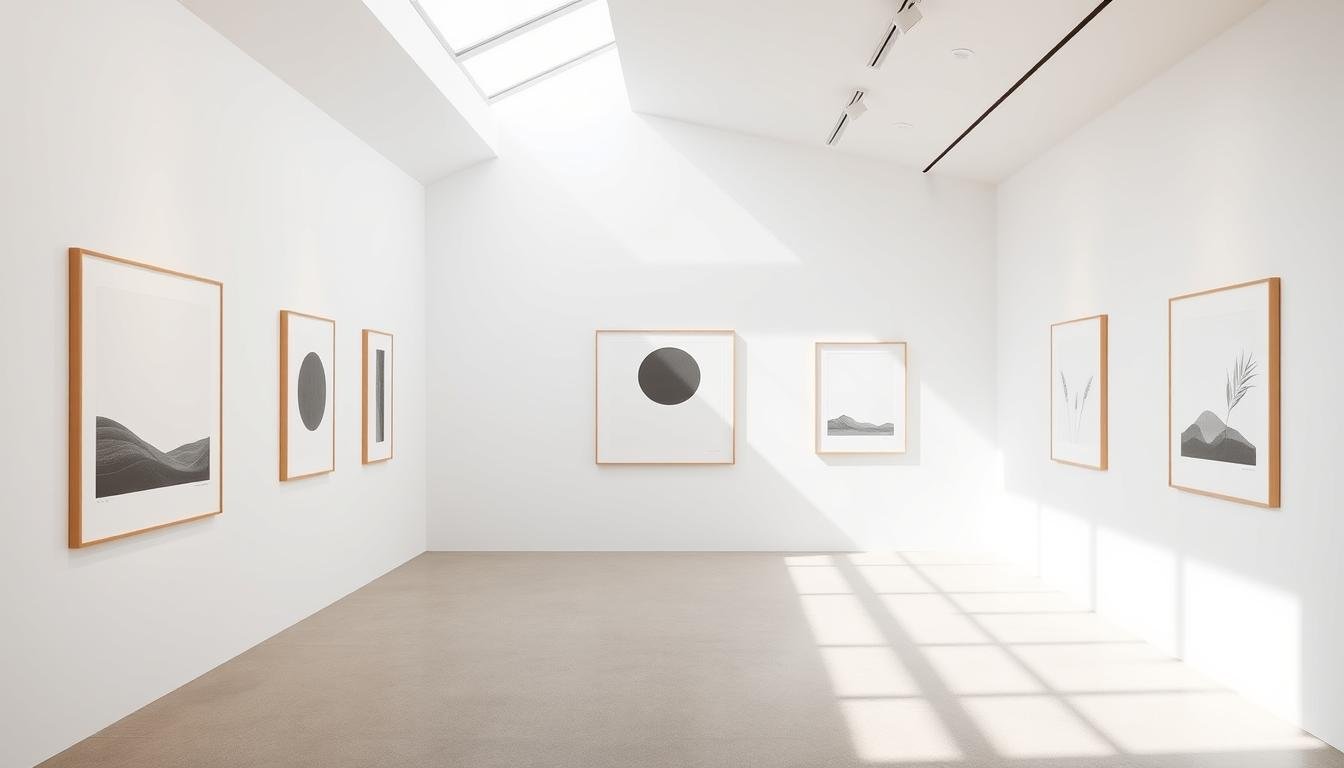Can a box, a strip of light, or a silent grid change how you feel in a room? This guide looks at a bold mid-1960s New York movement that pushed art toward radical simplicity.
Minimalism foregrounded the object as a whole. Artists used industrial materials, geometric clarity, and pared-down form to create works that read as single, unified experiences.
Roots run back to geometric abstraction and the Bauhaus ethos of "less is more." Painters like Ellsworth Kelly and Agnes Martin and sculptors such as Donald Judd, Dan Flavin, and Sol LeWitt helped shape a new visual language.
In this tour you will meet signature approaches — boxes, fluorescent light, grids, and floor pieces — and learn how they moved from gallery experiments to influence design and interiors in the United States.

Key Takeaways
- Minimalism began in mid-1960s New York and favors pared-down, industrial forms.
- Works emphasize the whole object over separate parts.
- Connections to Mondrian, Malevich, and Bauhaus show a longer modern lineage.
- Expect both sculptural and painterly paths: boxes, grids, and light installations.
- The movement shaped contemporary design, interiors, and visual culture.
Minimalism in Art: Origins, Ideas, and Why “Less Is More” Still Matters
In mid-century New York a new art practice sharpened attention to the object itself and trimmed theatrical gesture.
From Abstract Expressionism to the “specific object”
The movement grew as a clear counter to abstract expressionism. Instead of dramatic brushwork and personal myth, artists made work that stood as a fact.
“The thing as a whole… is what is interesting.”
Judd’s phrase captured a turn toward literal forms. The idea of a “specific object” reduced narrative and pushed viewers to meet geometry, lines, and color directly.
Geometric shapes, seriality, and industrial materials in the 1950s-1960s United States
Early threads trace to Mondrian, Malevich, and Bauhaus design. Proto steps came from 20th century painters such as Ellsworth Kelly, Rauschenberg, Robert Ryman, and Agnes Martin.
In the 1950s and 1960s many makers used fabrication, hardware, and new materials—steel, plywood, Plexiglas, and fluorescent fixtures—to assemble works. Geometric shapes and serial systems replaced illusion and storytelling.
| Trait | Example | Effect |
|---|---|---|
| Non-relational composition | Grids, single panels | Focus on proportion and form |
| Industrial materials | Steel, Plexiglas | Neutral finish, factory feel |
| Serial arrangements | Stacks, repeated modules | Rhythm without narrative |
| Proto-painting paths | Hard-edge, monochrome, grids | Prepared the field for sculptural work |
Why it matters today: reduced means sharpen perception. Simpler decisions intensify color and materials, and they change how rooms and galleries read.
To learn more about the origins and key terms, see what is minimalism.
The most famous minimalist artists
A tight circle of makers in 1960s New York reworked how art meets space, insisting that materials and placement shape meaning as much as form.
Donald Judd: Boxes, stacks, and the power of the whole
Donald Judd moved from painting to what he called the "specific object." He used plywood, steel, copper, and Plexiglas to build boxes and vertical stacks. These works treat the object and surrounding space as a single experience.
Dan Flavin: Fluorescent light, color, and spatial transformation
Dan Flavin turned commercial fluorescent fixtures into art. His colored light installations wash walls and corners, making viewers feel the room itself become part of the work.
Sol LeWitt: Wall drawings, structures, and the primacy of the idea
Sol LeWitt split his practice between written wall drawings and modular structures. He prioritized concept: instructions create the drawing, and open-cube structures follow set ratios.
Carl Andre: Floor pieces, grids, and material truth
Carl Andre laid identical units—bricks, copper tiles, or stones—directly on the floor. His low, walkable grids foreground material presence and the viewer’s movement across the piece.
Robert Morris: From mirrored cubes to process and performance
Robert Morris used mirrored cubes, Land Art gestures, and performance to test how simple forms change perception. His experiments connected Minimalism to post-minimal practices beyond the gallery.
"The thing as a whole… is what is interesting."
New York and the rise of the movement: Studios, galleries, and a new art language
SoHo’s metal shops and downtown galleries helped turn simple ideas into precise, repeatable sculptures.
New York’s ecosystem of studios, galleries, and fabricators made assembly a practical choice in the 1960s. Artists moved away from carving and casting. They relied on hardware stores and specialized shops to realize clean, hard-edged work.
SoHo’s scene connected makers with machinists and metal shops that could produce exact joins and uniform finishes. That partnership let artists test standardized units, serial repetition, and modular systems at scale.
Galleries began showing room-scaled installations that used walls, corners, and floors as active parts of the work. These presentations changed how viewers walked through space and perceived proportion and rhythm.
Judd, Marfa, and the reach beyond the city
Donald Judd encoded display into daily life by turning a SoHo building into a cohesive live-work-display environment. It illustrated how art and architecture could merge into a single aesthetic.
Judd then expanded to Marfa, where monumental works and permanent installations reoriented Minimalism to landscape and scale. The move showed that the movement’s strict geometries could adapt outside New York’s streets.
"The thing as a whole… is what is interesting."
- Local fabricators guaranteed precise finishes and repeatability.
- Serial systems and modules became a shared visual language.
- Concentrated critics and curators in New York accelerated recognition.
For a deeper look at how downtown galleries shaped the scene, see artist-run galleries in New York.
Minimalist painters who shaped the look of the movement
A cluster of painters shifted the canvas from window to object, using edges, bands, and quiet grids to redefine modern painting.
Ellsworth Kelly made hard-edged compositions and multi-panel works such as Red Yellow Blue II (1953). His shaped panels and chromatic modules treated color as a structural element. These studies set a clear vocabulary of edge, interval, and hue that informed later painting.
Agnes Martin
Martin favored pencil grids and muted washes. Her work reads as quiet abstraction and spiritual practice. Simple lines and tiny modulations create calm, disciplined surfaces.
Jo Baer
Baer framed white interiors with colored bands at the edges. The bands act like a frame and insist the painting is an object, not a view into illusion.
Robert Mangold
Mangold used shaped supports with drawn lines to play perimeter against interior. His paintings nod to classical proportion while keeping forms reduced.
Robert Ryman and Frank Stella
Ryman’s white-dominant work explores method and material. Stella’s early black-band series declared “what you see is what you see.” Together they pushed painting toward objecthood.
| Painter | Signature | Visual effect |
|---|---|---|
| Ellsworth Kelly | Shaped panels, spectrum | Color as boundary and interval |
| Agnes Martin | Pencil grids, muted washes | Serenity through line and proportion |
| Jo Baer | Edge bands | Painting asserted as object |
| Robert Mangold | Shaped supports, incised lines | Tension of perimeter vs. field |
| Ryman / Stella | White monochrome / black bands | Material method / direct seeing |
Light, space, and the West Coast sensibility
Along the sunlit coast, makers tuned surface and sight to make seeing feel active and new.
Light and Space and Finish Fetish creators treated illumination, finish, and color as primary materials. Their work grew from Southern California light, auto-body shops, and plastics culture.
Mary Corse: Glass microspheres, perception, and phenomenology
Mary Corse mixed glass microspheres into acrylic to build paintings that shift with angle and ambient light. The surface appears to breathe as viewers move, so perception becomes the subject.
John McCracken: Glossy planks and finish-fetish surfaces
John McCracken made sleek planks of fiberglass and resin that lean against walls. These objects compress sculpture and painting into reflective slabs that intensify colors and plane.
How artificial and natural light redefine color and space
Artificial light—from Dan Flavin’s fluorescent arrays to gallery fixtures—acts like paint. It alters color fields, stretches space, and links West Coast sensory work to New York reductionist practice.
- Fabrication: Auto-body and aerospace techniques enabled high-gloss finishes.
- Phenomenology: Works respond to viewer movement, ambient light, and architecture.
- Crosscurrents: Shared reduction and serial thinking tied this approach to Sol LeWitt and New York forms.
"Works that depend on light force us to move and rethink space."
Materials, color, and form: The vocabulary of Minimalism
Minimalism built a clear vocabulary from shop-ready parts and precise color planes.
Industrial units: Plexiglas, steel, plywood, and fluorescent fixtures

Plexiglas gave luminous edges and clean planes. Steel offered rigid lines and factory finishes. Plywood allowed modular joins and warm, flat surfaces. Fluorescent fixtures made light itself an object.
These materials shared uniformity and repeatable finishes. Fabrication produced exact joins and surfaces that remove craft gestures. The result: clarity and neutrality that focus the viewer on form and space.
Serial structures and modular systems
Seriality organizes both painting and sculpture. Repeated units—boxes, stacks, and grids—set rhythm and interval.
Lines, edges, and planes guide perception without narrative. Straight edges mark proportion. Planes define distance and scale. The object stands self-sufficient.
"The work exists as a whole—form and space in balance."
| Material | Role | Effect |
|---|---|---|
| Plexiglas | Translucency, tinted color | Color as structure, changing with light |
| Steel | Rigid support, industrial finish | Exactness, flatness, durable edges |
| Plywood | Modular panels, easy fabrication | Warm flatness, repeatable units |
| Fluorescent fixtures | Light as medium | Spatial activation, color fields |
Color in lacquer, tint, or painted plane becomes structural. It no longer illustrates; it defines interval, boundary, and depth. Standardized fabrication gives works consistent scale and finish so form and space read plainly and sharply.
Women shaping Minimalism and its edges
In the 1960s and 1970s a group of women used simple shapes to ask bigger questions about value and making.
Judy Chicago
Chicago used lean geometry and saturated color to build room-sized installations. Her Rainbow Pickett (1965/2004) arranges six trapezoids at 45 degrees to test color relationships at human scale.
Carmen Herrera
Herrera’s Estructuras sit between painting and sculpture. Works like Amarillo “Dos” (1971) use acrylic on wood and strict shapes to create calm, hard-edge statements.
Charlotte Posenenske
Posenenske made reproducible modules in corrugated cardboard. Series DW foregrounded concept over rarity and critiqued market systems by pricing work near material cost.
Eva Hesse
Hesse introduced pliable materials—fiberglass, resin, latex—into serial grids and boxes. Pieces such as Sans II (1968) soften strict repetition and point toward post-minimal expression.
| Artist | Signature Approach | Key Work / Date | Critical Move |
|---|---|---|---|
| Judy Chicago | Saturated trapezoids, installations | Rainbow Pickett (1965/2004) | Color as spatial test |
| Carmen Herrera | Hard-edge Estructuras | Amarillo “Dos” (1971) | Painting/relief unity |
| Charlotte Posenenske | Reproducible modules | Series DW (1968) | Anti-market distribution |
| Eva Hesse | Pliable serial forms | Sans II (1968) | Material process to post-minimal |
Why this matters: these women expanded the vocabulary of art by changing materials, shapes, and distribution. Their work reached audiences in New York and across the United States and reshaped how painting and object interact.
Dialogues with Abstract Expressionism and Conceptual Art
A direct line links the reduction of 1950s abstraction to the spare scale of later works.
Ad Reinhardt and Barnett Newman set important precedents. Reinhardt’s near-black canvases and Newman’s large fields with “zips” taught painters how scale and restraint could be expressive without gesture.
Ad Reinhardt, Barnett Newman, and the monochrome impulse
These painters reframed silence and monumentality. Their experiments made it easier for later makers to treat a single plane or an intense field as an entire work.

Concept and execution: Where Minimalism meets Conceptual Art
Sol LeWitt severed idea from hand. His instructions for wall drawings let others execute the work, turning the plan into the primary art object.
"The idea becomes a machine that makes the art."
Artists such as Rauschenberg, Ellsworth Kelly, Robert Ryman, and Agnes Martin bridged abstract expressionism and the new object-focused approach. Dan Flavin’s fluorescent installations pushed this further by making light a medium that re-maps space and perception.
- Newman and Reinhardt: scale and monochrome logic.
- Kelly, Ryman, Martin: links from expression to object clarity.
- LeWitt and Flavin: idea-led works and installations that alter architecture.
| Precedent | Effect | Later impact |
|---|---|---|
| Newman / Reinhardt | Monochrome scale | Supported minimal objecthood |
| LeWitt | Instruction-based work | Conceptual practice |
| Flavin | Light as medium | Space-activating installations |
Minimalism’s lasting influence on interiors and design in the United States
Across homes and public lobbies, pared-back works shape calm and order in ways furniture alone cannot.
Clean lines, simple forms, and restrained palettes translate the art approach into everyday rooms. This clarity creates visual breathing room and steady balance.
How a single work can anchor a space: a well-placed piece acts as a structural presence. It organizes sightlines and invites pause without adding clutter.
Clean lines, restrained palettes, and calm spaces
Designers borrow from Bauhaus and the “less is more” ethic to choose colors and finishes that support architecture. Color arrives through lacquered panels, tinted Plexiglas, or controlled illumination rather than busy pattern.
How artworks anchor rooms without overpowering them
Works by donald judd and Dan Flavin show two paths: objects that define volume and light that reshapes walls. Both strategies let paintings, sculptures, or fixtures sit with furniture and let nature and artificial light work together.
- Practical appeal: these pieces fit with modern or traditional decor.
- Placement tip: align art with architectural lines and natural light for cohesion.
- Material note: finishes and colors should echo room tones to maintain calm.
| Design move | How it translates | Effect in space |
|---|---|---|
| Single focal work | Box, plank, or light installation | Anchors sightlines, reduces visual noise |
| Restrained palette | Muted tones or singular color planes | Enhances calm, highlights form |
| Material color | Tinted Plexiglas, lacquer, illumination | Introduces controlled color without pattern |
"A quiet work lets a room breathe; it organizes feeling without shouting."
Conclusion
Minimalism gathered decades of experiment into a clear rule: reduce to reveal. The movement distilled a century of abstraction and made form and repeatable systems the primary language of an art movement.
Its painting and sculptural paths clarified how color and edge work together. Viewers meet works as unified facts, not narratives, and a single painter or object can change a room’s mood.
Figures across the field used industrial materials, grids, light, and stacks to reshape perception. Over time the approach has influenced design and the built world, keeping Minimalism alive in interiors and public space.
Explore the makers and specific works above to see how reduction sharpens attention and rewards close looking.
Enhance Your Space with Unique Modern Masterpieces by Chiara Rossetti
Are you inspired by the innovative mediums and conceptual depth highlighted in our exploration of contemporary art? You’re not alone! Today’s art enthusiasts are seeking cultural relevance and emotional connections in their artwork. However, finding pieces that resonate with modern themes and fit your unique style can be a challenge. That’s where we come in!
At Rossetti Art, we specialize in canvas prints, original paintings, and modern sculptures that celebrate the spirit of now. Each piece created by Chiara Rossetti brings a personal touch that connects deeply with current social narratives—just like the modern masterpieces discussed in the article. Don’t miss out on the chance to elevate your home decor with breathtaking artwork that speaks to your values and aesthetic. Explore our collection today and find your perfect piece! Act now, and transform your space into a gallery of inspiration!
FAQ
What is Minimalism in art and how did it emerge?
Minimalism is an art movement that emphasizes simplicity of form, exacting materials, and the removal of personal expression to focus on objecthood. It emerged in the United States in the late 1950s and 1960s as a reaction to Abstract Expressionism, favoring geometric shapes, serial structures, and industrial fabrication over gestural painting.
How did Abstract Expressionism influence Minimalism?
Abstract Expressionism pushed artists to interrogate the limits of painting and presence. Minimalists took that interrogation further by removing expressive brushwork and narrative content, proposing works as discrete objects or environments. The shift led to the “specific object” and a focus on material, scale, and viewer perception.
Who were key figures in the movement and what did they make?
Important figures include Donald Judd, known for his boxes and stacks; Dan Flavin, who used fluorescent light to alter space; Sol LeWitt, who advanced wall drawings and the primacy of concept; Carl Andre, who arranged floor-based grids; and Robert Morris, who explored process and installation. Each prioritized clarity of form and material honesty.
Why is New York important to Minimalism?
New York provided galleries, critics, and fabrication resources that allowed the movement to coalesce. SoHo studios, fabrication shops, and a network of dealers helped artists move from carved, handmade work to industrial assembly. The city became a hub where ideas, production, and exhibition intersected.
How did Donald Judd expand the movement beyond New York?
Judd established a significant presence in Marfa, Texas, where he installed site-specific works and fabricated units that emphasized space and permanence. Marfa became a testing ground for scale, installation, and how Minimalist works interact with landscape and architecture.
Which painters are associated with Minimalism and what distinguishes them?
Painters tied to the movement include Ellsworth Kelly, with hard-edge color panels; Agnes Martin, known for quiet grids and meditative restraint; Jo Baer, who treated the painting as an object with framed edges; Robert Mangold, for shaped canvases and linear clarity; and Robert Ryman and Frank Stella, who focused on monochrome surfaces and the literal presence of the painting.
What role did the West Coast play in Minimalist developments?
The West Coast introduced a sensibility that emphasized perception, light, and finish. Artists like Mary Corse used glass microspheres to change surface effects; John McCracken produced high-gloss planks emphasizing finish-fetish aesthetics. Both natural and artificial light became integral to how color and surface read in space.
What materials and strategies define Minimalist sculpture and painting?
Minimalists favored industrial materials—steel, Plexiglas, plywood, fluorescent fixtures—and methods like serial repetition, modular systems, and precise fabrication. The approach valued economy of means, surface clarity, and literal presence rather than illusion or narrative.
How did women contribute to and expand Minimalism?
Women artists brought diverse strategies that broadened the movement. Judy Chicago incorporated installation and color in feminist dialogues; Carmen Herrera refined hard-edge geometry and clarity; Charlotte Posenenske explored reproducible, anonymous units with an anti-market stance; and Eva Hesse introduced pliable, serial materials that bridged Minimalism and post-minimalism.
How does Minimalism relate to Conceptual Art?
Minimalism and Conceptual Art intersect where idea and execution share priority. Artists like Sol LeWitt placed concept at the center, using drawings and instructions that allowed works to be executed by others. Both movements questioned authorship and emphasized the viewer’s engagement with the idea or object.
What legacy has Minimalism left for interiors and design in the United States?
Minimalism influenced interior aesthetics through clean lines, restrained palettes, and uncluttered spaces. Artworks serve as anchors that define rooms without dominating them. The movement’s influence persists in architecture, furniture, and the contemporary preference for calm, functional spaces.
Where can I see landmark Minimalist works today?
Major museum collections in the United States and Europe hold key works: the Museum of Modern Art and the Guggenheim in New York, Dia Art Foundation in New York and Marfa, the San Francisco Museum of Modern Art, and Tate Modern in London. Visiting these institutions and dedicated sites like Marfa offers direct encounters with seminal pieces.







Leave a comment
This site is protected by hCaptcha and the hCaptcha Privacy Policy and Terms of Service apply.